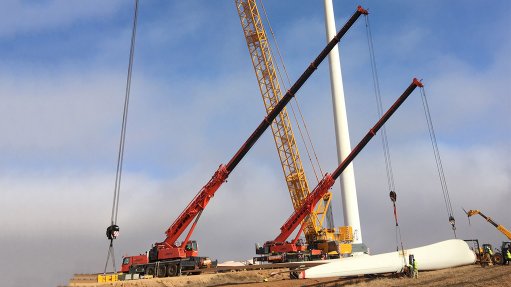
BIG LIFTS CALL FOR BIG EQUIPMENT Johnson Crane Hire's 750 t Liebherr LG 1750 lattice boom all terrain crane doing a wind farm installation
Heavy lifting equipment suppliers must sustain investment in the upgrade of lifting equipment fleets and other resources if they wish to remain competitive, advises lifting solutions provider Johnson Crane Hire sales executive Peter Yaman.
“The South African economy is experiencing a slight decline in big infrastructure project spending. However, despite the industry slowdown, projects currently under way need lifting equipment that is capable of heavier capacity than the industry has traditionally had to cater to.”
Yaman says there seems to be a continual and increased demand for bigger cranes, with the company having had to substantially upgrade the lifting capacity of its crane fleet. Yaman explains that, 25 years ago, the company’s biggest crane was a 180 tonner. He expands by saying that the company now has a 750 t crane in its fleet and has recently supplied a 1 200 t crane for a project-specific application. Johnson Crane Hire currently has three different 750 t capacity cranes in the fleet, which illustrates the demand for this heavy lifting capacity as well as the need to cater for diverse applications.
The growing demand for heavier capacity lifting equipment is predominantly driven by stricter safety considerations and the need to lift heavier components. This is a result of components being assembled at ground level which reduces the number of lifts required, and also reduces the risks of working at height, he explains.
Yaman says new technologies and advanced construction projects – for example, higher equipment installation projects such as those required in the wind energy market – are significant contributing factors to increased demand for heavier capacity equipment.
Yaman explains that, in the past, stationary lattice boom cranes sufficiently catered to the industry’s heavier capacity requirements, but that more mobile heavy capacity equipment is now required. “Users want cranes that are cheaper and faster to transport, saving on transport costs and potential downtime.”
However, he emphasises that it is a challenge for lifting equipment suppliers to simultaneously stay on top of economic pressures that force users to reduce production costs, while staying abreast of the latest heavy capacity demands and maintaining competitive pricing. “Continuing with fleet renewal and ensuring you have the right mix of equipment is a challenge.”
To remain competitive under such circumstances, suppliers must also endeavour to reduce their spending – cost-reduction endeavours cannot be at the expense of the quality of services supplied or the necessity for fleet renewals, Yaman advises.
He states that Johnson Crane Hire – which has been in operation since 1976, with a current market share of 35% – has managed these evolving industry challenges by reducing in-house expenses, but never at the expense of the safety or quality of the service it provides.
It is pivotal to stock the correct equipment to meet client requirements, which Johnson Crane Hire does successfully through its diverse fleet of 240 cranes, Yaman states, adding that the company has focused heavily on fleet renewals and upgrades over the past six years.
“Johnson Crane Hire’s brand promise is S.M.A.R.T – Safety, Maintenance, Availability, Reliability and Total cost effectiveness. What we tell our clients is that the cost effectiveness is not a result of cheaper rental prices or compromised products, but of delivering on the aspects of the brand promise.”